Graphic dictation in the cells of the task. Graphic dictation. Preparation for school.
Graphic dictations for preschoolers 6-7 years old
Preparing children for school is becoming one of the major areas in the work of a kindergarten with older children preschool age. Within such training, it is important for the teacher, on the one hand, to help the child master the skills and abilities that he will need in the first grade, on the other hand, to refrain from using purely school, teacher methods of conducting classes.
In order to cope with this difficult task, the teacher of preschool education needs to own his own, specific baggage of teaching methods and techniques.
The materials of Alexandra Sapozhnikova, a teacher at the Institute of Psychology named after A.I. L.S. Vygotsky RGGU.
Dictation is one of the "classic" school forms of control and learning. Primarily in the field of literacy testing. In order to successfully cope with dictations, in addition to specific subject skills, developed voluntary attention, the ability to clearly follow instructions and fit into the general rhythm of the group's work are required. These qualities can be trained with the help of special "graphic dictations" designed for children 5.5-6 years old.
Here is the classification and examples of such dictations proposed by Alexandra Sapozhnikova.
Coloring book dictations
All children have sheets with the same pictures for coloring, corresponding to the topic of the lesson, day or week. The adult says that, in what quantity and what color to paint, the children complete the task. If one of the children copes with the task faster than others, he can color in some other part of the drawing indicated by the adult. When all the children color the named part, everyone moves on to the next one - given by adults. Children who worked faster than others leave for a while the additional task that was given to them and work together with everyone; if they again complete the task before everyone else, then they do not sit idle, but return to the unfinished part.
Dictation example
All tasks are given with pauses, leaving the children time to complete them. Circle the points and color the upper fin of the fish in green, the lower fins in yellow. Color three large scales in red, and five small scales in blue. Circle the strip on the tail and make it blue, make the edge of the tail red. Color the bubbles under the fish in blue, but so that two large unpainted white bubbles remain, leave four large unpainted bubbles at the top right of the fish, leave two small unpainted bubbles at the top left of the fish.
Color the rest of the drawing as you wish.
At the end of the dictation or class, the work of all children is considered. Those that are made in good faith, beautifully and with high quality, are signed and posted in a specially designated place.
Drawing dictation
An adult tells the story slowly, calmly, with expression, but not very emotionally. At the same time, he draws what he is talking about on the board. Children draw in albums. They focus on the story, on the board. You do not need to copy the drawing on the board. Looking at the board, children learn to compare their work with the image, to correlate it with what they saw and heard. At later stages of training, drawing dictations are carried out without relying on a sample on the board. This work option is also possible: an adult or a child works at the blackboard, but the result shows when the dictation is finished.
Dictation example
First option
The story is told calmly, rather slowly.
The sky is covered with clouds. Heavy. Low. Long.(Adult draws on the board.)
To the right, the sun broke through them. But it doesn't heat up at all.(Adult draws.)
The wind is harsh and gusty. When a gust of wind blows, big waves appear on the sea(adult draws)
gradually they subside, subside, subside(draws)
and become very small. With a new gust of wind, they again rise large, formidable(draws)
and again subside, subside, subside(draws)
.
The bottom is difficult, unusual. It's all lined with long flat slabs.(adult draws) . The plates fit so tightly together that the bottom itself is almost invisible.(adult draws) . But in some places, algae have attached themselves to the bottom.(draws) : on the right - three, and on the left - two. They sprouted between the stones and stretch, stretch, stretch up to the sun(draws) . On the far right slab are two large shells.(draws) . These are rapana(draws) . They slowly got up and(draws) creep. Next to them - two more small shells - small rapanchiki(draws) . On the far left slab lies a large starfish(adult draws) . She is beautiful and bright. I want to touch her. And here is another - a small star(draws) .
Small fish swim between the algae(draws) . There are seven(draws) . A huge fish swam behind the small fish on the right(adult draws) , followed by another(draws) . They tried to catch small fish, but the small fish hid in the seaweed. Then the big fish swam towards the rapans. Looking for something to eat. Smaller fish swimming in the upper left(draws) but also large. There are four(draws) . They eat algae. They bite off a piece - swim a little, swallow it. Then they float again.
Left coast. He is cool (draws). This is part of the rock. On it stands a fisherman - a young man (draws). Strong. In a striped sweater (draws), hat, pants (draws), warm boots (draws). He is fishing (draws).
Second option
The sea is calm and calm. From time to time a breeze blows and the sea ripples(adult draws) .
The wind drove the clouds. Three. One is big(draws) , the other is smaller and the third is very small(draws) .
To the right, the sun is just rising. The first rays appeared(draws) . The bottom is made up of stones. different. Round, oval, long, elongated along the bottom(draws) .
Clams are crawling over the stones from left to right. A lot of them(draws ). They crawl to the algae - to have breakfast. Three small algae grow on the right(draws) , further - two more(draws). But all the mollusks crawl here, to the large thickets of algae. And small fish swam to them. Fish five(draws ). And three bigger fish sailed behind them(draws) . They stop and think about what to eat - algae or shellfish. While they were thinking, a huge fish swam(draws) . She doesn't need algae or shellfish. She loves fish.
On the shore - a raft. It consists of thick logs knocked together by planks. (draws). On a raft - a boy (draws). He is shaggy - he was in such a hurry to go fishing that he did not even comb his hair (draws). He is fishing (draws).
Cell dictation
This is a well-known type of graphic dictation, when an adult dictates how many cells and in what direction a line needs to be drawn to make a pattern or drawing.
"Graphic dictation".
Graphic dictation is the execution of patterns, drawings from dictation. Develops the ability to hear and understand, verbal instructions, perform tasks according to the model than models learning activities schoolboy. This task is one of the most common in diagnosing a child's readiness for school and, therefore, one of the most frequently used in the development of his volitionality.
I think some of you will object to me that a child is not a computer and should not be a dumb performer, but agree that the ability to listen and hear is an important quality that is necessary not only in school, but also useful in life.
To complete the task, the child will need a sheet of paper in a box, a simple pencil and an eraser. The execution rules depend on the type of graphic dictation, which can be divided into three types:
Linear - a pattern made in a line. The child is dictated the first part, consisting of one or two complete cycles, then he performs himself according to the pattern he already has, understanding the logic of the pattern execution;
Volumetric - a three-dimensional drawing is performed under dictation, which is subsequently copied side by side. When the child is trained to copy the direct image, invite him to practice copying the reverse as well, that is, by turning the picture in a mirror image;
Artistic - it is extremely difficult to dictate them, and, probably, in this case it is not so relevant. The thing is that the drawing that is being prepared for the child on a checkered sheet has many starting points and, accordingly, many lines. Therefore, in this case, the installation is given only for copying the picture (Figure 6).
Linear graphic dictations.
1) 1 up, 1 to the right, 1 down, 1 to the right, 1 up, 1 to the right, 1 down, 1 to the right, then continue, please yourself, to the end of the line ...
2) 1 up, 1 right, 1 down, 1 right, 2 up, 1 right, 2 down, 1 right, 1 up, 1 right, 1 down, 1 right, 2 up, 1 right, 2 down, 1 right...
3) 1 up, 1 left, 1 up, 1 right, 1 up, 1 right, 1 down, 1 right, 1 down, 1 left, 1 down, 3 right...
4) 5 up, 3 right, 1 down, 2 left, 1 down, 1 right, 1 down, 1 left, 1 down, 2 right, 1 down, 1 right...
5) 2 up, 2 right, 1 down, 1 left, 1 down, 2 right...
6) 5 up, 1 diagonally left up, 2 up, 1 right, 1 down, 1 right, 1 up, 1 right, 1 down, 1 right, 1 up, 1 right, 2 down, 1 diagonally left down, 5 down, 3 right...
7) 2 up, 1 diagonally right down, 1 diagonally right up, 2 down, 1 right ...
8) 1 diagonally right up, 1 left, 1 up, 1 right, 2 down, 1 right ...
9) 3 up, 1 right, 2 down, 1 right, 1 up, 1 right, 1 down, 1 right, 2 up, 1 right, 3 down, 1 right…
10) 1 up, 1 left, 1 up, 1 right, 1 up, 1 right, 1 up, 1 right, 1 down, 1 right, 1 down, 1 right, 1 down, 1 left, 1 down, 3 right…
11) 1 up, 1 right, 1 up, 1 left, 1 up, 3 right, 1 down, 1 left, 1 down, 1 right, 1 down, 1 right…
12) 1 up, 1 diagonally right up, 1 diagonally right down, 1 down, 1 right ...
13) 1 diagonally left down, 1 diagonally right down, 1 diagonally right up, 1 diagonally left up, 3 right ...
14) 1 up, 1 left, 1 up, 1 diagonally right down, 3 up, 1 diagonally left down, 1 up, 1 right, 1 diagonally left up, 1 right, 1 down, 1 diagonally right up, 1 down, 1 left, 1 diagonal right down, 1 left, 3 down, 3 right…
15) 3 up, 2 right, 1 down, 1 left, 1 down, 1 right, 1 down, 1 right…
16) 2 up, 1 right, 1 down, 1 right, 1 up, 1 right, 2 down, 1 right, 1 up, 1 right, 1 down, 1 right, 2 up…
17) 1 diagonally right up, 1 left, 1 diagonally right up, 1 diagonally right down, 1 left, 1 diagonally right down, 1 right ...
18) 1 right, 4 up, 1 left, 1 diagonally right up, 1 diagonally right down, 3 up, 1 diagonally right up, 2 diagonally right down, 2 left, 1 down, 1 diagonally right down, 4 diagonally left down, 2 down, 7 right...
19) 1 diagonally left up, 1 right, 2 up, 1 diagonally right down, 1 diagonally left down, 2 right, 1 diagonally left down, 3 right ...
20) 1 diagonally left up, 1 right, 1 diagonally right down, 1 up, 1 right, 1 down, 1 diagonally right up, 1 right, 1 diagonally left down, 3 right ...
21) 1 up, 1 right, 1 diagonal right up, 1 diagonal right down, 1 right, 1 down, 1 right ...
22) 3 right, 1 down, 1 right, 1 up…
23) 2 up, 1 diagonally right down, 1 diagonally right up, 2 down, 1 right, 1 up, 1 right, 1 down, 1 right ...
24) 1 diagonally right up, 1 diagonally right down, 2 diagonally right up, 2 diagonally right down ...
25) 2 diagonally right up, 1 diagonally right down, 1 diagonally right up, 2 diagonally right down, 1 diagonally right up, 1 diagonally right down ...
26) 1 diagonally right up, 1 right, 1 diagonally left down, 1 right ...
27) 1 diagonally right up, 1 diagonally left up, 1 right, 1 diagonally right down, 1 diagonally left down, 1 right ...
28) 1 diagonally right up, 1 diagonally left up, 1 right, 1 diagonally right down, 1 diagonally right up, 1 right, 1 diagonally left down, 1 diagonally right down, 1 right ...
29) 1 diagonally right up, 1 diagonally left up, 1 right, 1 diagonally right down, 1 diagonally left down, 3 right, 1 diagonally left up, 1 diagonally right up, 1 right, 1 diagonally left down, 1 diagonally right down, 1 right…
30) 1 diagonally left down, 1 right, 1 diagonally left down, 1 right, 1 diagonally left down, 2 right, 1 diagonally right up, 1 left, 1 diagonally right up, 1 left, 1 diagonally right up, 2 left...
Volumetric graphic dictations.
1) 2 right, 1 up, 1 right, 2 up, 1 right, 1 down, 1 right, 1 up, 1 right, 1 down, 1 right, 1 up, 1 right, 2 down, 4 left, 1 down, 1 left, 3 down, 1 right, 1 down, 6 right, 3 down, 1 left, 4 down, 1 left, 2 up, 1 left, 1 up, 3 left, 3 down, 1 left, 4 up, 1 left , 1 up, 1 left, 4 up, 1 left, 2 up. (deer).
2) 4 right, 1 up, 3 right, 1 up, 1 right, 1 down, 1 right, 2 down, 1 left, 1 down, 5 right, 2 down, 1 left, 1 down, 1 left, 1 down, 8 left, 1 up, 1 left, 1 up, 1 left, 1 up, 1 right, 1 up, 2 right, 1 up, 4 left, 1 up. (tank).
3) 1 right, 1 diagonally left up, 1 diagonally right up, 2 up, 2 left, 2 up, 1 right, 1 down, 1 right, 1 up, 1 right, 1 diagonally left up, 1 up, 1 left, 1 up, 1 right, 1 down, 3 right, 1 up, 1 right, 1 down, 1 left, 1 down, 1 diagonal left down, 1 right, 1 down, 1 right, 1 up, 1 right , 2 down, 2 left, 2 down, 1 diagonal down right, 1 diagonal down left, 1 right. (bear).
4) 2 down, 2 right, 2 up, 3 left, 3 diagonally right up, 2 right, 1 diagonally right down, 1 up, 1 right, 2 down, 1 diagonally right down, 3 down, 8 left, 3 up. (house).
5) 3 diagonally right up, 2 left, 2 diagonally right up, 1 left, 2 diagonally right up, 2 diagonally right down, 1 left, 2 diagonally right down, 2 left, 3 diagonally right down, 8 to the left. (Christmas tree).
6) 1 up, 2 right, 2 diagonally right up, 2 right, 1 diagonally right down, 2 down, 2 left, 1 up, 1 diagonally left down, 4 left. (boot).
7) 2 diagonally right up, 3 right, 1 diagonally right up, 1 diagonally right down, 2 left, 2 diagonally right down, 2 diagonally right up, 4 down, 2 diagonally left up, 2 diagonally left down, 2 right, 1 diagonally left down, 1 diagonally left up, 3 left, 2 diagonally left up. (fish).
8) 2 right, 1 diagonally left up, 2 up, 1 diagonally right down, 1 diagonally right up, 2 down, 1 diagonally right down, 2 down, 1 diagonally right up, 2 up, 1 diagonally right up, 1 diagonally right down, 2 down, 2 diagonally left down, 4 left, 1 diagonally right up, 2 diagonally left up. (squirrel).
9) 1 right, 2 up, 2 right, 1 down, 1 right, 1 down, 3 right, 1 down, 2 right, 3 up, 1 right, 5 down, 1 left, 1 down, 1 left, 1 down, 2 left, 1 up, 1 right, 1 up, 3 left, 1 down, 1 left, 1 down, 2 left, 1 up, 1 right, 2 up, 1 left, 1 up, 1 left, 1 up. (dog).
10) 2 diagonally right up, 3 up, 2 diagonally right up, 2 diagonally right down, 2 right, 2 diagonally right down, 4 down, 2 left, 2 up, 2 left, 2 down, 2 left, 4 up, 2 diagonally left down, 1 down, 2 left. (elephant).
11) 2 right, 2 diagonally right up, 2 right, 2 diagonally right down, 2 diagonally right up, 2 diagonally right down, 2 left, 2 diagonally left down, 2 down, 2 diagonally left up, 2 left, 2 diagonal left down, 2 up, 2 diagonal left up. (turtle).
12) 1 diagonally right up, 2 diagonally left up, 3 up, 2 diagonally right down, 2 diagonally right up, 3 down, 3 right, 3 up, 2 diagonally right down, 2 down, 2 diagonally down left, 6 left. (kitty).
13) 1 up, 1 right, 2 up, 1 diagonally left up, 3 up, 2 diagonally right down, 2 diagonally right up, 3 down, 3 right, 3 up, 2 diagonally right down, 2 down, 1 diagonal left down, 1 down, 1 diagonal left down, 2 left, 1 up, 1 right, 1 up, 3 left, 1 up, 1 diagonal left down, 2 left. (cat).
14) 4 up, 1 right, 1 up, 1 left, 4 up, 1 right, 1 down, 1 right, 1 down, 1 right, 1 down, 1 right, 2 up, 1 right, 2 down, 1 right, 1 up, 1 right, 1 up, 1 right, 1 up, 1 right, 4 down, 1 left, 1 down, 1 right, 4 down, 1 left, 1 up, 1 left, 1 up, 1 left, 1 up , 1 left, 2 down, 1 left, 2 up, 1 left, 1 down, 1 left, 1 down, 1 left, 1 down, 1 left. (butterfly).
15) 2 right, 1 diagonally left up, 4 left, 1 up, 1 right, 1 up, 1 right, 1 down, 2 right, 1 down. (mouse).
16) 2 up, 3 right, 1 up, 1 right, 4 down, 4 right, 2 up, 1 left, 1 up, 2 right, 7 down, 1 left, 2 up, 4 left, 2 down, 1 right, 5 up, 3 left. (dog).
17) 1 left, 2 up, 1 left, 1 down, 2 right, 2 down, 4 right, 1 up, 1 left, 2 up, 1 right, 1 up, 1 right, 1 down, 1 right, 2 down, 1 left, 1 down, 2 right, 1 diagonal right down, 2 down, 1 diagonal left down, 2 up, 1 diagonal left up, 3 down, 1 right, 1 down, 1 right, 1 down, 1 right , 1 down, 1 right, 1 down, 11 left, 1 up, 1 right, 1 up, 1 right, 1 up, 1 right, 1 up, 1 right, 3 up, 2 left, 1 diagonally up left. (girl).
18) 2 diagonally left up, 1 up, 1 diagonally right up, 1 diagonally left up, 3 up, 3 diagonally right up, 2 right, 1 diagonally left down, 3 diagonally left up, 1 up, 1 left, 1 diagonal up left, 1 up, 1 diagonal up right, 1 right, 1 diagonal down right, 1 down, 1 diagonal up left, 1 diagonal down left, 1 diagonal down right, 1 down diagonal up right, 4 right, 1 up, 1 diagonal up right, 1 right, 1 diagonal down right, 1 down, 1 diagonal down left, 1 left, 1 diagonal up left, 1 diagonal up right, 1 diagonal right down, 1 diagonal left down, 1 down, 2 diagonal left down, 3 diagonal right down, 3 down, 1 diagonal left down, 1 right, 1 diagonal right up, 1 right, 1 diagonal down right, 2 left, 1 diagonal down left, 1 down, 2 diagonal down left, 4 left. (mouse).
19) 3 diagonally right up, 1 up, 1 diagonally right up, 2 down, 1 diagonally right up, 1 right, 1 diagonally left down, 1 diagonally right down, 8 down, 1 diagonally right down, 6 right, 1 diagonal right down, 1 down, 1 right, 2 diagonal right down, 1 down, 1 diagonal left down, 2 up, 1 diagonal left up, 1 left, 9 down, 1 left, 8 up , 1 left, 8 down, 1 left 8 up, 3 left, 8 down, 1 left, 8 up, 1 left, 8 down, 1 left 9 up, 1 diagonally up left, 9 up, 1 left, 2 diagonally left down, 1 diagonally left up, 1 up. (giraffe).
20) 2 up, 1 diagonally right up, 1 right, 1 diagonally right down, 1 down, 2 diagonally right down, 2 right, 3 diagonally right up, 1 right, 1 diagonally left down, 3 down, 2 diagonal left down, 2 left, 1 diagonal left down, 2 down, 1 right, 1 down, 1 diagonal left up, 1 diagonal left down, 1 left, 1 diagonal right up, 2 up, 1 diagonal up left, 1 left, 1 diagonal up left, 2 up, 1 diagonal up left, 1 left, 1 diagonal up right. (chick).
21) 3 right, 2 diagonally right down, 1 down, 1 diagonally left up, 4 down, 2 left, 2 up, 3 left, 2 down, 2 left, 4 up, 1 diagonally left down, 3 left, 2 up, 1 right, 1 down, 1 right, 2 up, 2 diagonal right up, 2 right, 1 diagonal right down, 3 down, 1 diagonal left down, 1 diagonal left up, 1 up. (elephant).
22) 2 diagonally right up, 1 right, 1 diagonally right down, 2 down, 4 diagonally left down, 4 diagonally left up, 2 up, 1 diagonally right up, 1 right, 2 diagonally right down. (heart).
23) 1 diagonally right up, 3 up, 3 left, 1 up, 1 right, 1 up, 1 right, 1 up, 1 right, 4 up, 1 diagonally left down, 2 down, 1 diagonally left down, 4 up, 1 diagonal up right, 2 right, 1 up, 1 diagonal up left, 1 up, 2 diagonal down left, 1 down, 1 diagonal up right, 2 up, 2 diagonal up right, 1 right , 2 diagonal right down, 2 down, 1 diagonal right down, 1 up, 2 diagonal left up, 1 down, 1 diagonal left down, 1 down, 2 right, 1 diagonal right down, 4 down, 1 diagonal left up, 2 up, 1 diagonal left up, 4 down, 1 right, 1 down, 1 right, 1 down, 1 right, 1 down, 3 left, 3 down, 1 diagonal down right, 2 left, 4 up, 1 left, 4 down, 2 left. (girl).
24) 3 up, 1 diagonally right up, 1 right, 2 diagonally right up, 2 down, 1 diagonally left down, 1 left, 1 diagonally left down, 2 left, 1 diagonally left up, 1 left, 1 diagonal left up, 2 up, 2 diagonal right down, 1 right, 1 diagonal right down, 8 up, 1 diagonal right up, 2 right, 1 diagonal right down, 1 down, 1 right, 1 down diagonally right down, 2 down, 1 diagonally left up, 1 diagonally left down, 1 diagonally left up, 1 diagonally left down, 2 up, 1 diagonally right up, 1 right. (bell).
25) 4 up, 3 diagonally right down, 1 diagonally left down, 2 right, 2 diagonally left down, 3 left, 2 up, 3 right. (ship).
26) 3 diagonal left down, 8 down, 1 diagonal left down, 1 left, 1 diagonal left down, 1 left, 1 diagonal left up, 2 up, 1 diagonal right up, 1 up, 1 diagonal up right, 1 up, 1 diagonal up left, 1 up, 2 diagonal up right, 1 right, 1 diagonal down right, 2 right, 1 diagonal up right, 1 right, 2 diagonal down right, 1 down , 1 diagonal left down, 1 down, 1 diagonal right down, 1 down, 1 diagonal right down, 2 down, 1 diagonal left down, 1 left, 1 diagonal left up, 1 left, 1 diagonal left up, 2 left, 1 diagonal right down, 1 diagonal right up, 8 up, 3 diagonally left up. (butterfly).
27) 1 up, 1 right, 1 up, 1 right, 1 up, 1 right, 1 down, 1 right, 1 down, 1 right, 1 down, 1 left, 1 down, 1 left, 1 down, 1 left, 1 up, 1 left, 1 up, 1 left. (rhombus).
28) 1 diagonally right up, 2 up, 1 left, 1 up, 1 left, 1 up, 1 right, 1 up, 1 right, 1 up, 1 right, 1 down, 1 right, 1 down, 1 right, 1 down, 1 left, 1 down, 1 left, 2 down, 1 diagonally right down, 3 left. (tree).
29) 2 up, 2 diagonally right down, 2 right, 2 diagonally right up, 2 down, 2 diagonally left up, 2 left, 2 diagonally left down. (candy).
30) 2 diagonally right up, 3 right, 2 diagonally right down, 2 right, 2 down, 2 left, 1 diagonally left up, 1 diagonally left down, 4 left, 1 diagonally left up, 1 diagonally down left, 1 left, 2 up, 9 right. (car).
These tasks can be used in various lessons at school. As they are presented above, for example, in mathematics lessons in primary school in addition to the main goal - the development of attention, additionally with the aim of developing orientation in the space of students. In middle school mathematics lessons, you can use this task, for example, when mastering a rectangular coordinate system, setting the direction of the drawing lines with mathematical coordinates.
Put the points in the coordinate system and connect them sequentially:
" (-4,4); (-3,4); (-3,6); (-1,6); (-1,5); (0,5); (0,4); (3,4); (3,3); (5,3); (5,6); (6,6); (6,1); (5,1); (5,0); (4,0); (4,-1); (2,-1); (2,0); (3,0); (3,1); (0,1); (0,0); (-1,0); (-1,-1); (-3,-1); (-3,0); (-2,0); (-2,2); (-3,2); (-3,3); (-4,3); (-4,4).
" (-4,-2); (-4,-1); (-2,-1); (0,1); (2,1); (3,0); (3,-2); (1,-2); (1,-1); (0,-2); (-4,-2).
" (-4,3); (-4,-3); (2,-3); (2,3); (-1,6); (-4,3); (2,3).
" (0,0); (1,1); (1,5); (2,6); (3,5); (3,1); (4,0); (4,-3); (3,-2); (2,-3); (1,-2); (0,-3); (0,0).
" (0,3); (1,1); (3,1); (1,0); (2,-2); (0,-2); (-2,-2); (-1,0); (-3,1); (-1,1); (0,3).
You can use this type of assignments in geography or natural science, introducing children to the designation of parts of the world.
" 2 north, 1 northeast, 1 east, 1 southeast, 1 south, 2 southeast, 2 east, 3 northeast, 1 east, 1 southwest , 3 south, 2 southwest, 2 west, 1 southwest, 2 south, 1 east, 1 south, 1 northwest, 1 southwest, 1 west, 1 northeast, 2 north, 1 northwest, 1 west, 1 northwest, 2 north, 1 northwest, 1 west, 1 northeast.
"3 East, 2 Southeast, 1 South, 1 Northwest, 4 South, 2 West, 2 North, 3 West, 2 South, 2 West, 4 North, 1 southwest, 3 west, 2 north, 1 east, 1 south, 1 east, 2 north, 2 northeast, 2 east, 1 southeast, 3 south, 1 southwest, 1 northwest, 1 north.
"2 northeast, 1 east, 1 southeast, 2 south, 4 southwest, 4 northwest, 2 north, 1 northeast, 1 east, 2 south -East.
"1 southwest, 2 north, 1 southeast, 2 north, 1 west, 2 northwest, 3 north, 2 west, 2 northeast, 2 southeast , 2 south, 3 east, 2 northeast, 3 south, 2 southwest, 2 west.
"6 southeast, 6 northeast, 12 west, 9 south, 12 east, 9 north.
In addition to the purely technical tasks that were proposed above, we can suggest complicating this task even more by introducing elements of creativity into it. Firstly, the child can be invited to come up with a pattern or pattern himself. This kind of creative activity is shown even by preschool children, although, of course, this kind of task can be quite difficult for them, but I think it’s not worth denying them this pleasure. And secondly, you can give the child the opportunity to dictate his own image for performance by another child or a group of children under his dictation. These two types of tasks are the most difficult and require a certain level of development of the child's various skills.
Preparing a child for school is an event that is responsible not only for the child himself, but also for the parents. Moms and dads are advised to avoid two extremes: to let education take its course or, conversely, to overload their child with developmental activities.
The optimal interaction with a preschooler is play. Children are interested in playing. In games, they are happy to do what they would not do in other situations. For example, a kid does not want to recite poems by heart, but if you ask a child to act as a teacher and tell a poem to a bunny or a bear, the result will exceed all expectations.
One of the components of preparation for school is the development of fine motor skills of the child. IN kindergarten and at home, children draw, sculpt, perform finger gymnastics exercises. To prevent such classes from being boring, adults came up with graphic dictations for preschoolers.
What is graphic dictation?
The difference between graphic and other types of dictations is that lines are drawn in a box on a sheet of paper. The result is a schematic representation of an object or living being.
Preschoolers are offered a large cage. The following tasks have been developed:
- copy the pattern according to the sample;
- draw according to the instructions of an adult;
- create an image on your own, focusing on conventions"3", "4↓", etc. (the number shows the number of cells, the arrow shows the direction).
The topics of graphic dictations are different: "Hare", "Elephant", "Snake", "Ship", etc.
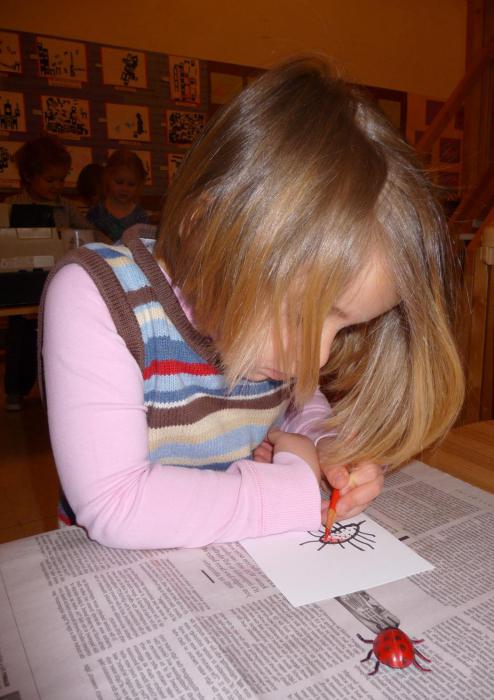
What are the benefits of such exercises?
Thanks to graphic dictations, the child develops attention, memory, spatial thinking, and imagination. The kid learns to count, to navigate on a sheet of paper, to bring things to the end.
Graphic dictations for preschoolers contribute to the formation of spelling vigilance, overcoming restlessness, absent-mindedness of the child. Taking a great interest in drawing by cells, future first grader he himself does not notice how his attention becomes arbitrary, his thoughts become more logical, how interest is formed in completing assignments in a notebook. Conversations with the child about the depicted object, animal, person expand the horizons of the baby, contribute to speech development crumbs.
What do you need for a graphic dictation?
First of all - a notebook in a large cage. If the child learns to draw well in large cells, then you can offer a graphic dictation by cells in a standard notebook. The sheets on which the exercises are performed should not be too bright and smooth. Glare distracts from the task and harms the eyes.
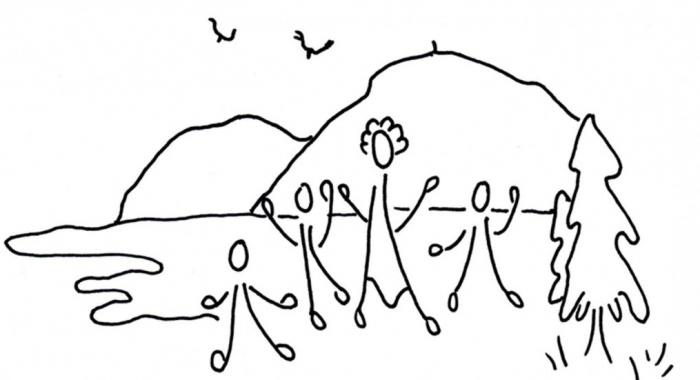
In addition to a notebook, you will need a sharpened simple pencil and an eraser. If you write a graphic dictation with a pen, then it will be almost impossible to correct errors.
Hygienic conditions
Since classes are held at the table, you need to choose the right furniture for the child. IN preschool this is a common practice, and parents should take care of the comfort of the baby at home. It is better to buy a children's table and chair. But if this is not possible, then you can perform tasks at the desk, but substitute a support under the child’s feet. The angle between the lower leg and thigh should be 90°. An adult makes sure that the baby does not slouch, does not lean low over the notebook, does not hang his elbows off the table.
Methodology
Graphic dictations for preschoolers are carried out in several stages. The first stage is preparatory. An adult arouses interest in the child in the upcoming work, sets up to complete the task. Poems, riddles, tongue twisters, stories about the depicted object help to attract the attention of the baby. You can perform finger gymnastics, sing a song, depict an animal or an inanimate object using facial expressions and gestures.
An adult shows the child how to hold a pencil correctly (hold it between the phalanges of the index and middle fingers, hold it with the thumb), specifies where the top, bottom, right, left are on the sheet of paper.
The second stage of the methodology is the actual execution of the work. Depending on the variant of the task, the kid copies the drawing according to the model, listens to the instructions of an adult, or focuses on conventional signs. During copying, the teacher or parent suggests that the child first count the number of cells and determine the direction of the segment on the sample, then draw the same thing in a notebook.
If a dictation is planned by ear, then before doing the exercise, you need to help the child count the correct number of cells before setting the first point and ask him to place the pencil lead exactly at this point. Further instructions should be very clear. For example, the graphic dictation "Rocket":
- three cells on top, seven on the left, period;
- four cells down, period;
- one cell to the right, one cell down, dot;
- one cell down, dot;
- one cell down, dot;
- one cell left, one cell down, dot;
- one cell left, one up, dot;
- two cells to the left, full stop;
- one cell down, one cell left, dot;
- one cell up, dot;
- one cell up, one cell to the right, dot;
- four cells up, period;
- draw a rocket point by point and color it.
After completing the work, you can invite the child to color the resulting picture.

The most difficult option is a graphic dictation by symbols. The future student studies the symbols and completes the task himself. An adult helps only with setting the first point. Regardless of the task option, the graphic dictation in the cells is performed without taking the pencil off the paper.
During the dictation, it is necessary to control the child, to help the baby. At first, it is recommended to follow the implementation of each step.
Participation in classes must be voluntary. Children like to write graphic dictations for preschoolers, so if a child does not want to study, there are objective reasons for this. Maybe the baby is tired, or he is interested in something else. Let your child rest and do not distract from activities. After some time, he will be ready to switch attention.
In kindergarten, teachers try to interest children with the help of surprise moments (a fox brings a picture with a dictation in a bag), games (a bunny asks children to draw his portrait), problem situation(doll Katya wants to order a painting, and the artist has gone on a business trip), etc.
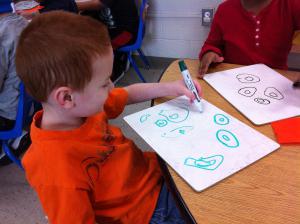
How to respond to mistakes?
The Graphic Dictation technique is one of the most difficult, so mistakes are inevitable. An eraser helps to correct annoying mistakes. If you didn’t notice a mistake, and the result was rubbish, you should not be upset. Support the baby and praise him for his efforts.
Perhaps the proposed dictation turned out to be too difficult, next time stop at an easier option. Before starting the lesson, count homogeneous objects and once again check the directions on a piece of paper.
Preschoolers are very sensitive to negative evaluation, therefore, negative statements and even more sweeping criticism should be avoided. Point out shortcomings in the work correctly. Tell your child that he will do better next time.
Class time
Since kids cannot do one thing for a long time, the time for classes is limited. Graphic dictations for children 5-6 years old are designed for fifteen to twenty minutes. With six-year-olds, they take up to twenty-five minutes. Time can be increased if the child is interested. Try to complete the task to the end.
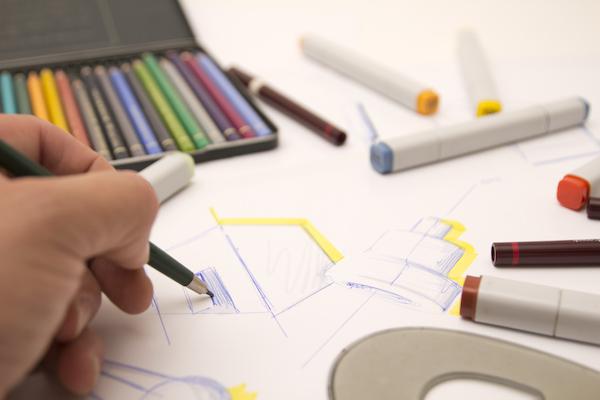
Graphic dictations in elementary school
With first-graders, such exercises are used in the lessons of the Russian language, natural history, classes with a speech therapist, in an extended day group. The technique of "Graphic dictation" is somewhat different here. Notebooks in a standard cage are used, the topics and content of the drawings become more complicated.
In addition to drawing itself, teachers conduct conversations on the content of the dictation. Teachers expand the mathematical knowledge of schoolchildren (part, whole, area of figures), form natural history ideas (about the habits, lifestyle of a drawn animal). Children continue to develop attention, thinking, imagination, coherent speech (vision in a schematic representation of an object, drawing up a fairy tale, a story from a drawing, reasoning on given topics, etc.). The listed knowledge, skills and abilities help to successfully study in all subjects of the school curriculum.
Of a very different nature - designers, various electronic tutorials, puzzles, mosaics and much more. All of them help to develop very important skills in a child - attention, perseverance, develop logic and thinking.
Today I want to offer you another interesting view developing activities - graphic dictation. I'm just in love with him. To be honest, it is no less interesting and exciting for me than my son to complete the task in order to see at the end what was encrypted in the picture.
Geographical dictation is drawing by cells. The path for drawing is prescribed, and if you complete the task clearly and correctly, you will end up with some kind of image (a dog, a car, etc.). The process itself is very exciting, since the picture is born before your eyes, you want to complete the task faster to see what was encrypted, but you can’t rush, because in a hurry you can do something wrong and then the image will not work.
Graphic dictation is very useful for preschoolers. It helps to develop very important skills in a child - attentiveness, perseverance, coordination of movement, fine motor skills of fingers.
How to conduct a lesson with graphic dictations
1. Print the name of the picture you like, the dictation itself is written below (numbers with arrows). Just in case, I'll explain the notation:
2 - means that you need to draw a line 2 cells down,
3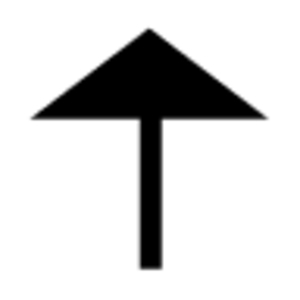 - means that you need to draw a line 3 cells up,
- means that you need to draw a line 3 cells up,
5 - draw a line 5 cells to the right,
- draw a line 5 cells to the right,
2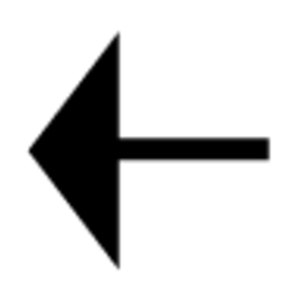 - draw a line 2 cells to the left,
- draw a line 2 cells to the left,
1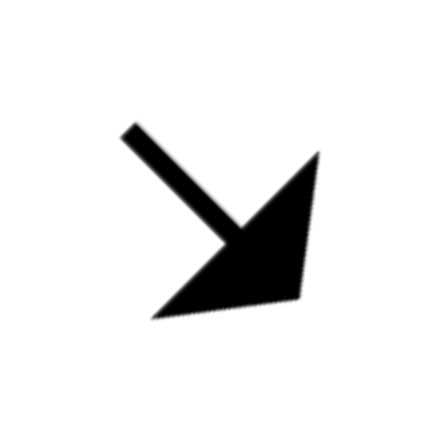 - diagonal down and to the right by one cell
- diagonal down and to the right by one cell
2 - diagonal down and to the left by two cells
- diagonal down and to the left by two cells
2 - diagonal up and to the left by two cells
- diagonal up and to the left by two cells
3 - diagonal up and to the right by two cells
- diagonal up and to the right by two cells
2. There is a dot in the figure - this is the starting point, the task must be performed from it.
3. The lesson itself can be carried out in two ways - you dictate the moves to the child, or he does it on his own, looking at the path (my son has been doing it himself for 5 years so as not to get confused by the task that he circled around, then he himself draws some more done in the picture).
Whoever feels his own attractiveness becomes attractive

